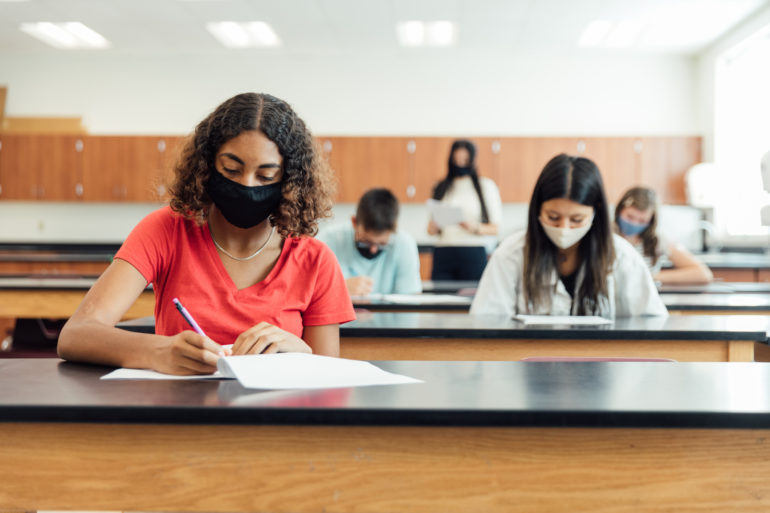Many high school students on day nine or later of their COVID-19 quarantine period tested positive for the virus, a University of Florida study published in JAMA has found. The finding suggests schools should adopt a policy of testing quarantined students if they return to class before the end of the standard 14-day quarantine period in order to limit COVID-19 transmission in schools.
In the study, the UF team found more than 8% of high school students who were quarantined as a close contact of a person infected with COVID-19 (within 6 feet for 15 total minutes) tested positive for the virus on days 9 to 14 of quarantine.
A new University of Florida study suggests schools should adopt a policy of testing quarantined students if they return to class before the end of the standard 14-day quarantine period
“The study underscores the importance of testing. If you do no testing and send kids back between days 10 to 14 of quarantine, a substantial portion of high school kids will go back to school infected,” said Sarah McKune, Ph.D., one of the study’s authors and a research assistant professor in the department of environmental and global health at the UF College of Public Health and Health Professions and the UF Center for African Studies.
“While Centers for Disease Control and Prevention guidance recommends a 14-day quarantine, it also presents options for shortened quarantines as acceptable alternatives, allowing for non-tested, quarantined students to return to school after Day 10. Our findings indicate that this is probably not a good practice for high school students,” McKune added.
The CDC currently recommends a 14-day quarantine period for close contacts of COVID-19 cases, but in December released guidelines for local public health authorities to shorten quarantines. Options include ending quarantine after Day 10 without testing if no symptoms have been reported, or ending quarantine after Day 7 if a diagnostic test is negative and no symptoms are reported.
The UF team evaluated COVID-19 test results among students in Alachua County, Florida. The Florida Department of Health in Alachua County conducted testing, contact tracing and follow-up as part of its COVID-19 surveillance in schools.
At the start of the fall semester, the county implemented a policy of quarantining students who were contacts of confirmed COVID-19 cases and offering testing at Day 3 and at Day 9 of quarantine, which was sometimes delayed to days 10 to 14, according to student scheduling and how the days fell around weekends. Asymptomatic students who tested negative on days 9 to 14 could return to school on the day following their negative test. If no test was administered, a 14-day quarantine was required.
Between Aug. 1 and Nov. 30, 2020, 2,189 students at the county’s 49 public and charter K-12 schools were quarantined as close contacts of confirmed cases. Of those, 134 students were tested on Day 3 and 839 students were tested on days 9 to 14. Among high school students, 8.2% tested positive for COVID-19 on days 9 to 14, compared with 1.8% of elementary and middle school students on days 9 to 14 of quarantine.
The age difference in late-stage quarantine positivity rates may be caused by both biological and behavioral differences between high school students and younger students, the researchers said. Scientists are increasingly finding teens are clinically similar to adults when it comes to COVID-19 infection.
“In addition, high school students have behaviors that increase their risk of infection in general,” McKune said. “They are more likely to be involved in extracurricular activities, including sports, which is where many of these contacts are occurring. They are also more likely to break social distancing norms and engage in close social contact with friends.”
Testing all students before return from quarantine may not be possible in some school systems because of the expense, the researchers said, so following the CDC’s recommendation for a full 14-day quarantine may be a good option, particularly for high school students.
“As more data are available, there needs to be consideration that high school students may need to fall under different policy guidelines than elementary school students,” McKune said. “It is unclear how a rise in SARS-CoV-2 variants will impact guidance moving forward, but our team continues to monitor the data in case changes need to be made.”
In addition to McKune, the study team includes UF faculty Eric Nelson, M.D., Ph.D., the paper’s lead author and an assistant professor in the departments of pediatrics and environmental and global health; Kathleen Ryan, M.D., a clinical associate professor of pediatrics; John Lednicky, Ph.D., a research professor in environmental and global health; and J. Glenn Morris, M.P.H. & T.M, director of the Emerging Pathogens Institute. Team members from the Florida Department of Health include Susanne Crowe, M.H.A., laboratory director, and Paul Myers, M.S., administrator of the Florida Department of Health in Alachua County.
This story originally appeared on UF Health.
Check out stories about UF research on COVID-19.

